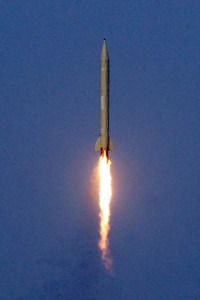
Shahab 3 MRBM launch during Iranian military exercise on July 3. (Photo credit: ARASH KHAMOOSHI/AFP/GettyImages)
By Greg Thielmann Last week the Pentagon delivered to Congress an unclassified report on Iranian military power, containing just enough information to leave its readers yearning for more. Signed on June 29 by Defense Secretary Leon Panetta, the report also was provided in a classified edition, according to Tony Capaccio, who broke the story for Bloomberg News. Missile Programs The most interesting and potentially newsworthy portion of the report is its description of Iranian missile work, including efforts to improve the survivability of short-range ballistic missiles against missile defenses and to develop "seekers that enable the missile to identify and maneuver towards ships during flight." Significantly, the report identifies rather than verifies Iran's claims to have deployed such missiles. The report notes Iran's success in "boosting lethality and effectiveness [of medium-range ballistic missiles] through accuracy improvements and submunition payloads." Although some commentators have portrayed this as a new development, identical language can be found in the DoD's April 2010 Unclassified Report on Military Power in Iran. Given the enormous attention given in American political circles to defending against future Iranian intercontinental ballistic missiles (ICBMs), which are expected by many members of Congress to arrive in 2015, one is compelled to search the report for evidence that Iran is reaching the milestones that would make such a contingency possible. But one searches in vain. The report includes nothing to suggest a shift in emphasis from short- and medium-range to longer-range missiles. Although the technological advances highlighted would have applicability for ICBMs or intermediate-range ballistic missiles (IRBMs), they are being applied to SRBMs and MRBMs. Moreover, one of the stepping stones to achieving longer-range missile capabilities is to complete testing and fielding of the most sophisticated (two-stage, solid-fueled) missile in the program to date, the 2,200 km-range Sejjil/Ashura. Last flight-tested in February 2011, this MRBM has apparently still not been deployed. The estimative mantra in the U.S. Government for at least two years has been: "With sufficient foreign assistance, Iran could probably develop and test an [ICBM] capable of reaching the United States by 2015." The latest formulation in the 2012 report's Executive Summary is slightly different: "With sufficient foreign assistance, Iran may be technically capable of flight-testing an intercontinental ballistic missile by 2015." Changing "could probably develop..." to "may be technically capable of..." sounds like ratcheting the odds downward a notch. Although the all-important qualifier, "with sufficient foreign assistance" has never been spelled out, leaving a wide of possible interpretations, the U.S. intelligence community and the UN Panel of Experts on the Iran sanctions have referred to Iran's continuing dependence on foreign suppliers for some key missile components. Given the extensive testing required for ICBM programs, the continuing lack of longer-range missile flight-tests and the continued wait for first-flight of Iran's largest space launch vehicle, the Simorgh, introduced in mockup on February 3, 2010, a downgrading of the 2015 scenario in terms of both probability and relevance seems entirely appropriate. Nuclear Programs Predictably, the report also highlights the status of Iran's nuclear programs. It summarizes Iran's progress in expanding its uranium enrichment capability and building a low-enriched uranium stockpile, and its continuing failure to fully cooperate with the International Atomic Energy Agency (IAEA). The report also reminds readers that Iran has not yet made a decision to produce nuclear weapons and signals uncertainty about the extent of current work on such weapons, citing IAEA evidence of Iran's "past and possibly ongoing (emphasis added) nuclear weapons-related research and development." Conventional Forces It is difficult to evaluate the report's conclusion that "Iran's conventional military capabilities continue to improve," based only on Iran's acquisition of new ships and submarines, and its expanded breadth of naval operations. Iran has clearly improved its domestic arms industry, but can this compensate fully for the UN Security Council Resolution 1929's ban on foreign sales to Iran of major weapons systems? Independent assessments of the gaps in radar coverage, the poor readiness of fixed-wing aviation, tensions between the IRGC and the regular military suggest otherwise. Moreover, an evaluation of the quality of training and operational readiness is absent from the report. Careful reading by Members of Congress of this congressionally mandated report is recommended. One can only hope that the classified version provides to Members and their cleared staffs some of the vital information missing in the unclassified report available to the public.
